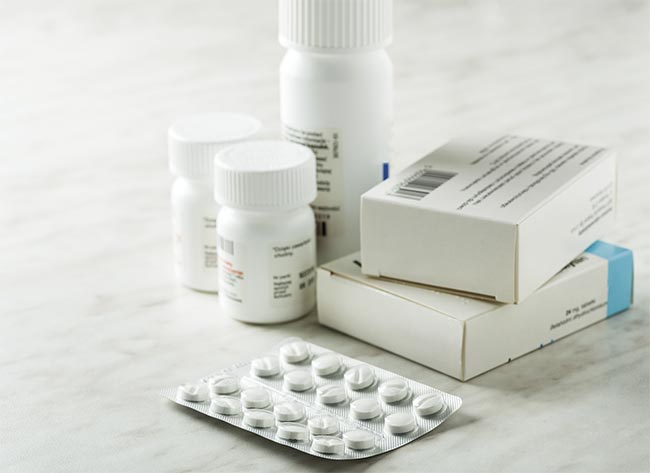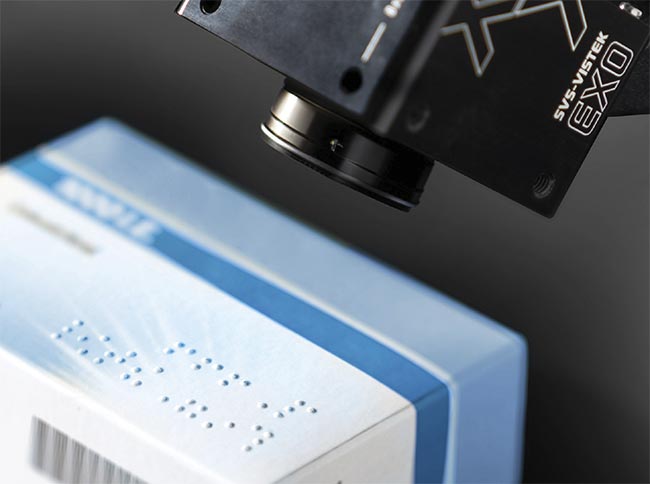DOMINIC V. ACQUISTA, DEPARTMENTS EDITOR

Courtesy of iStock.com/rlat.
There are 256 million people out of the global population who are visually impaired, according to data compiled by the National Library of Medicine. Many of them rely on braille, a system of touch reading and writing, which can be read on embossed paper or by using refreshable displays.
Pharmaceutical manufacturers have included braille on their packaging for years, an effort that was formalized in 2005 in Europe when the European Union passed a directive requiring braille text on all pharmaceutical products marketed in member countries. But with the new requirement, the realization emerged that manufacturers must ensure their braille embossing was done perfectly, every time. The omission of a single dot could mean the
difference between 100 mg and 500 mg, potentially leading to risks of underdosing or overdosing.

Using light that is projected from different directions, the DotScan system is able to take multiple images, creating a pseudo-3D image that can accurately determine the height and appearance of braille dots. Courtesy of in-situ GmbH.
Considering this potential health risk, an industrial image processing specialist in-situ GmbH, based in Sauerlach, Germany, was tasked with developing a system specifically designed to inspect the quality of braille dots to ensure that every dot is in its correct place.
Challenges of scanning dots
The first task was to understand how braille dots are produced on packaging. There are two ways of embossing
braille dots, according to in-situ managing director Sandra Söll. The first comes in the earlier stages of packaging, when completely printed sheets are punched by a machine. The second comes later, using rotary embossing tools during further processing of the boxes in a gluing machine.
The system in-situ developed was designed to check braille on empty, unfolded folding boxes offline during the production process.
“It is important that the inspection is carried out on the printed side. This is how we ensure that the front is correct, where [people with visual impairment] feel the braille indications,” Söll said.
Choosing placement is important, because a poorly assembled layout can be just as confusing as having a total misprint. Making sure the dots are embossed well, if at all, can be a hard task in its own right.
“The difficulty lies in checking the heights of the braille dots on the printed side of the pharmaceutical packaging,” Söll said.

The EXO camera from SVS-Vistek uses shape-from-shading to check braille embossing on pharmaceutical packaging. Courtesy of SVS-Vistek.
This would be a challenge for any human inspector, because it is difficult to see how pronounced the dots should be if an inspector is not regularly reading them. For an optical system, this poses the same challenge, so
in-situ sought to find a solution.
The company developed a system called DotScan, which includes an EXO camera from partner SVS-Vistek. The customized system for braille inspection compares embossed dots against reference files, employing a technique called shape-from-shading.
“It uses light from different illumination directions. The SVS-Vistek camera has the ability to control the illumination in use,” Söll said.
Factors such as illumination control, along with resolution and field of view versus cost, weighed heavily on the developers’ minds during the creation of the DotScan system.
Illumination control needed to be accounted for because it affected the recording speed of the system. The company’s preferred method of capturing images is to take multiple shots under different lighting conditions and directions to calculate pseudo-3D images. The company has already achieved results with this shape-from-shading method in many of its installations.
With SVS-Vistek’s EXO camera,
in-situ was also able to determine that it would be easier for the customer to set up the system due to the minimal number of drivers that need to be installed.
Having fewer drivers is a benefit to both the producer and the consumer, because as the system becomes too expensive to make, it becomes too expensive to buy. Realizing this, a 20-MP camera with rolling shutter that only needs to take five images per scan instead of nine, due to the use of 12-bit images, was added. This was achieved by controlling the illumination via the camera, where the images can be captured in synchronization with the lighting.
“As a result, the time for image acquisition could be reduced by ~60%,” Söll said.
System efficiency
The reduction of the DotScan’s image acquisition time has additional benefits, which help move the process along significantly. Because of this quick turnaround, in-situ’s system and SVS-Vistek’s camera benefit from an increased range of functions that are vital to producing accurate braille dots.
“By using the new camera, that
offers a larger field of view, higher resolution, and a shorter time for image
acquisition, additional functions could be implemented,” Söll said. “The shorter image acquisition time is important because the additional functions take longer to be evaluated. Since the cycle time should not become longer, this had to be compensated with the image acquisition.”
This efficiency in design leads to
efficiency in practice.
With the selected image processing
setup and the shape-from-shading technology implemented with it, the DotScan systems are able to verify the embossed braille labels at speeds of <1.5 s per pack. With a height verification of ±0.02 mm, the DotScan detects existing errors by comparing them to a reference sheet, equating to 40 sheets per minute of error-free braille.
Future implementation
While in-situ cannot divulge which pharmaceutical companies are using the DotScan system thus far, they have said that German pharmaceutical
companies and global packaging groups use ~200 DotScan systems to check braille embossing in more than 30 braille languages on medicine packaging. Packaging groups include
companies such as August Faller GmbH & CO., K.G. International, and Essentra.
The EXO model cameras from
SVS-Vistek have seen implementation
in other places, and according to Christian Schaarschmidt, sales director for the region of Germany, Austria, and Switzerland (DACH) for SVS-Vistek,
the line is used mainly for surface inspection.
As for the DotScan itself, in-situ has developed two other versions of the system, including a braille PDF reader for prepress when checking incoming reference PDF files or comparing two braille texts in PDF, and a high-speed scanner for books and magazines
written in braille.